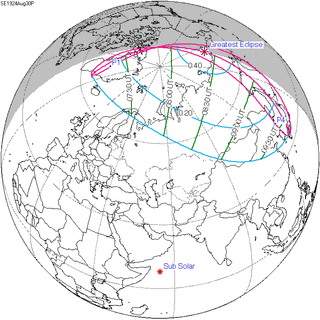Solar eclipse of August 30, 1924
| Solar eclipse of August 30, 1924 | |
|---|---|
| Type of eclipse | |
| Nature | Partial |
| Gamma | 1.3123 |
| Magnitude | 0.4245 |
| Maximum eclipse | |
| Coordinates | 71°30′N 172°54′E / 71.5°N 172.9°E |
| Times (UTC) | |
| Greatest eclipse | 8:23:00 |
| References | |
| Saros | 153 (4 of 70) |
| Catalog # (SE5000) | 9337 |
A partial solar eclipse occurred at the Moon's ascending node of orbit on Saturday, August 30, 1924, with a magnitude of 0.4245. A solar eclipse occurs when the Moon passes between Earth and the Sun, thereby totally or partly obscuring the image of the Sun for a viewer on Earth. A partial solar eclipse occurs in the polar regions of the Earth when the center of the Moon's shadow misses the Earth.
Related eclipses
[edit]Eclipses in 1924
[edit]- A total lunar eclipse on February 20.
- A partial solar eclipse on March 5.
- A partial solar eclipse on July 31.
- A total lunar eclipse on August 14.
- A partial solar eclipse on August 30.
Metonic
[edit]- Preceded by: Solar eclipse of November 10, 1920
- Followed by: Solar eclipse of June 17, 1928
Tzolkinex
[edit]- Preceded by: Solar eclipse of July 19, 1917
- Followed by: Solar eclipse of October 11, 1931
Half-Saros
[edit]- Preceded by: Lunar eclipse of August 24, 1915
- Followed by: Lunar eclipse of September 4, 1933
Tritos
[edit]- Preceded by: Solar eclipse of September 30, 1913
- Followed by: Solar eclipse of July 30, 1935
Solar Saros 153
[edit]- Preceded by: Solar eclipse of August 20, 1906
- Followed by: Solar eclipse of September 10, 1942
Inex
[edit]- Preceded by: Solar eclipse of September 18, 1895
- Followed by: Solar eclipse of August 9, 1953
Triad
[edit]- Preceded by: Solar eclipse of October 29, 1837
- Followed by: Solar eclipse of July 1, 2011
Solar eclipses of 1921–1924
[edit]This eclipse is a member of a semester series. An eclipse in a semester series of solar eclipses repeats approximately every 177 days and 4 hours (a semester) at alternating nodes of the Moon's orbit.[1]
The partial solar eclipse on July 31, 1924 occurs in the next lunar year eclipse set.
| Solar eclipse series sets from 1921 to 1924 | ||||||
|---|---|---|---|---|---|---|
| Descending node | Ascending node | |||||
| Saros | Map | Gamma | Saros | Map | Gamma | |
| 118 | April 8, 1921 Annular |
0.8869 | 123 | October 1, 1921 Total |
−0.9383 | |
| 128 | March 28, 1922 Annular |
0.1711 | 133 | September 21, 1922 Total |
−0.213 | |
| 138 | March 17, 1923 Annular |
−0.5438 | 143 | September 10, 1923 Total |
0.5149 | |
| 148 | March 5, 1924 Partial |
−1.2232 | 153 | August 30, 1924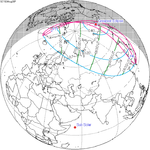 Partial |
1.3123 | |
Saros 153
[edit]This eclipse is a part of Saros series 153, repeating every 18 years, 11 days, and containing 70 events. The series started with a partial solar eclipse on July 28, 1870. It contains annular eclipses from December 17, 2104 through May 26, 2970. There are no hybrid or total eclipses in this set. The series ends at member 70 as a partial eclipse on August 22, 3114. Its eclipses are tabulated in three columns; every third eclipse in the same column is one exeligmos apart, so they all cast shadows over approximately the same parts of the Earth.
The longest duration of annularity will be produced by member 38 at 7 minutes, 1 seconds on September 5, 2537. All eclipses in this series occur at the Moon’s ascending node of orbit.[2]
| Series members 1–19 occur between 1870 and 2200: | ||
|---|---|---|
| 1 | 2 | 3 |
 July 28, 1870 |
 August 7, 1888 |
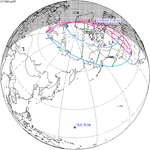 August 20, 1906 |
| 4 | 5 | 6 |
 August 30, 1924 |
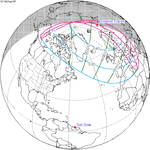 September 10, 1942 |
 September 20, 1960 |
| 7 | 8 | 9 |
 October 2, 1978 |
 October 12, 1996 |
 October 23, 2014 |
| 10 | 11 | 12 |
 November 3, 2032 |
 November 14, 2050 |
 November 24, 2068 |
| 13 | 14 | 15 |
 December 6, 2086 |
 December 17, 2104 |
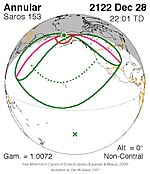 December 28, 2122 |
| 16 | 17 | 18 |
 January 8, 2141 |
 January 19, 2159 |
 January 29, 2177 |
| 19 | ||
 February 10, 2195 | ||
Metonic series
[edit]The metonic series repeats eclipses every 19 years (6939.69 days), lasting about 5 cycles. Eclipses occur in nearly the same calendar date. In addition, the octon subseries repeats 1/5 of that or every 3.8 years (1387.94 days). All eclipses in this table occur at the Moon's ascending node.
| 25 eclipse events between April 5, 1837 and June 17, 1928 | ||||
|---|---|---|---|---|
| April 5–6 | January 22–23 | November 10–11 | August 28–30 | June 17–18 |
| 107 | 109 | 111 | 113 | 115 |
 April 5, 1837 |
 January 22, 1841 |
 November 10, 1844 |
 August 28, 1848 |
 June 17, 1852 |
| 117 | 119 | 121 | 123 | 125 |
 April 5, 1856 |
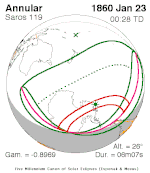 January 23, 1860 |
 November 11, 1863 |
 August 29, 1867 |
 June 18, 1871 |
| 127 | 129 | 131 | 133 | 135 |
 April 6, 1875 |
 January 22, 1879 |
 November 10, 1882 |
 August 29, 1886 |
 June 17, 1890 |
| 137 | 139 | 141 | 143 | 145 |
 April 6, 1894 |
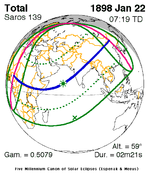 January 22, 1898 |
 November 11, 1901 |
 August 30, 1905 |
 June 17, 1909 |
| 147 | 149 | 151 | 153 | 155 |
 April 6, 1913 |
 January 23, 1917 |
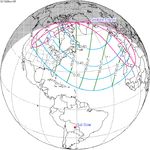 November 10, 1920 |
 August 30, 1924 |
 June 17, 1928 |
Tritos series
[edit]This eclipse is a part of a tritos cycle, repeating at alternating nodes every 135 synodic months (≈ 3986.63 days, or 11 years minus 1 month). Their appearance and longitude are irregular due to a lack of synchronization with the anomalistic month (period of perigee), but groupings of 3 tritos cycles (≈ 33 years minus 3 months) come close (≈ 434.044 anomalistic months), so eclipses are similar in these groupings.
| Series members between 1801 and 1946 | ||||
|---|---|---|---|---|
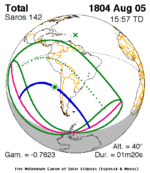 August 5, 1804 (Saros 142) |
 July 6, 1815 (Saros 143) |
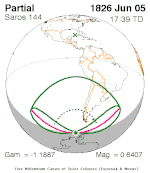 June 5, 1826 (Saros 144) |
 May 4, 1837 (Saros 145) |
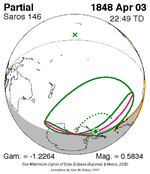 April 3, 1848 (Saros 146) |
 March 4, 1859 (Saros 147) |
 January 31, 1870 (Saros 148) |
 December 31, 1880 (Saros 149) |
 December 1, 1891 (Saros 150) |
 October 31, 1902 (Saros 151) |
 September 30, 1913 (Saros 152) |
 August 30, 1924 (Saros 153) |
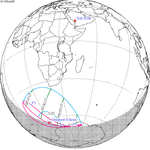 July 30, 1935 (Saros 154) |
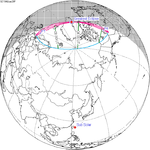 June 29, 1946 (Saros 155) | |
Inex series
[edit]This eclipse is a part of the long period inex cycle, repeating at alternating nodes, every 358 synodic months (≈ 10,571.95 days, or 29 years minus 20 days). Their appearance and longitude are irregular due to a lack of synchronization with the anomalistic month (period of perigee). However, groupings of 3 inex cycles (≈ 87 years minus 2 months) comes close (≈ 1,151.02 anomalistic months), so eclipses are similar in these groupings.
| Series members between 1801 and 2069 | ||
|---|---|---|
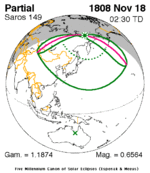 November 18, 1808 (Saros 149) |
 October 29, 1837 (Saros 150) |
 October 8, 1866 (Saros 151) |
 September 18, 1895 (Saros 152) |
 August 30, 1924 (Saros 153) |
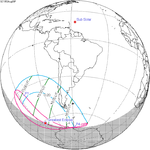 August 9, 1953 (Saros 154) |
 July 20, 1982 (Saros 155) |
 July 1, 2011 (Saros 156) |
|
 May 20, 2069 (Saros 158) |
||
References
[edit]- ^ van Gent, R.H. "Solar- and Lunar-Eclipse Predictions from Antiquity to the Present". A Catalogue of Eclipse Cycles. Utrecht University. Retrieved 6 October 2018.
- ^ "NASA - Catalog of Solar Eclipses of Saros 153". eclipse.gsfc.nasa.gov.
External links
[edit]- Earth visibility chart and eclipse statistics Eclipse Predictions by Fred Espenak, NASA/GSFC

